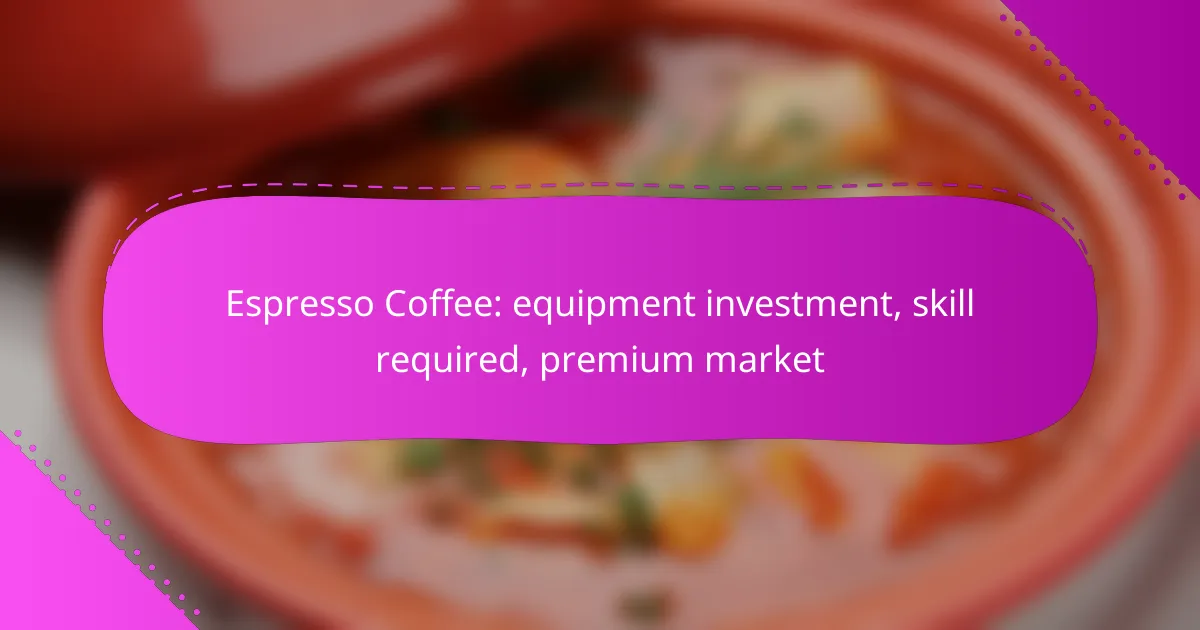Investing in espresso coffee equipment can significantly enhance your brewing experience, with options ranging from a few hundred to several thousand New Zealand dollars. The right machine, combined with essential skills like understanding grind size and extraction timing, is crucial for crafting a premium espresso. Whether for home use or in a café, selecting quality equipment and honing your technique can elevate your coffee-making to new heights.

What espresso machines are best for home use in New Zealand?
For home use in New Zealand, the best espresso machines combine quality, ease of use, and affordability. Popular choices include models that offer a balance of features suitable for both beginners and experienced baristas.
Breville Barista Express
The Breville Barista Express is a highly regarded machine that integrates a grinder with an espresso maker, making it ideal for those who want fresh coffee grounds. It features a user-friendly interface and allows for precise control over brewing parameters.
Consider its built-in conical burr grinder, which ensures consistent grind size and flavor extraction. The machine also has a steam wand for frothing milk, making it versatile for various coffee drinks.
De’Longhi La Specialista
The De’Longhi La Specialista stands out for its dual heating system, which allows simultaneous brewing and steaming. This feature is particularly beneficial for those who enjoy lattes or cappuccinos, as it reduces wait times.
This machine includes a sensor grinding technology that adjusts the grind size automatically, ensuring optimal extraction. Its easy-to-use interface makes it suitable for both novices and experienced users.
Rancilio Silvia
The Rancilio Silvia is a classic choice known for its durability and professional-grade performance. It is a semi-automatic machine that requires some skill to operate, making it ideal for those looking to refine their barista skills.
While it lacks a built-in grinder, pairing it with a quality grinder can significantly enhance the espresso experience. The Silvia’s robust construction and ability to produce high-quality espresso make it a favorite among coffee enthusiasts.

How much should you invest in espresso equipment?
Investing in espresso equipment typically ranges from a few hundred to several thousand New Zealand dollars, depending on the quality and features desired. Your budget will influence not only the machine’s capabilities but also the overall coffee experience you can create at home or in a café setting.
Entry-level machines under NZD 500
Entry-level espresso machines are ideal for beginners looking to explore the world of espresso without a significant financial commitment. These machines often feature basic functionality and may include a steam wand for frothing milk.
When considering an entry-level machine, look for models that offer good build quality and user-friendly interfaces. Brands like Breville and De’Longhi provide reliable options in this price range, making it easier to start your espresso journey.
Mid-range machines between NZD 500 and NZD 1500
Mid-range espresso machines offer a balance of quality and features, making them suitable for enthusiasts who want to refine their skills. These machines typically come with better temperature control, more powerful pumps, and enhanced steaming capabilities.
Investing in a mid-range machine allows for greater customization and consistency in brewing. Popular choices include machines from Rancilio and Gaggia, which provide a solid foundation for creating café-quality espresso at home.
High-end machines over NZD 1500
High-end espresso machines cater to serious coffee aficionados and professionals, featuring advanced technology and superior craftsmanship. These machines often include dual boilers, PID temperature control, and commercial-grade components.
When purchasing a high-end machine, consider the long-term benefits of durability and performance. Brands like La Marzocco and Rocket Espresso are renowned for their premium offerings, ensuring that your investment yields exceptional espresso for years to come.

What skills are required for making espresso?
Making espresso requires a combination of technical skills and an understanding of the brewing process. Key skills include knowledge of grind size, tamping technique, and extraction timing, each of which plays a critical role in producing a quality shot of espresso.
Understanding grind size
Grind size is crucial for espresso because it affects the extraction process. A finer grind increases surface area, allowing water to extract flavors more efficiently, while a coarser grind can lead to under-extraction and a sour taste. Aim for a grind that resembles table salt, adjusting slightly based on your machine and coffee type.
Experiment with different grind sizes to find the optimal setting for your espresso machine. A good starting point is to use a burr grinder, which provides consistent particle size, essential for achieving balanced extraction.
Mastering tamping technique
Tamping is the process of compressing the coffee grounds in the portafilter to create a uniform surface for water to flow through. Proper tamping ensures even extraction and prevents channeling, where water flows unevenly through the coffee. Apply firm, even pressure—around 30 pounds of force is a common guideline.
Practice your tamping technique by using a level tamper and checking for consistency. Avoid over-tamping, as this can lead to excessive pressure and a bitter taste. A good tamp should feel solid but not overly forceful.
Learning extraction timing
Extraction timing refers to how long water is in contact with the coffee grounds during brewing. For espresso, the ideal extraction time typically ranges from 25 to 30 seconds. This timing can vary based on grind size, dose, and tamping technique, so adjustments may be necessary.
Use a timer to monitor your extraction time closely. If your espresso is brewing too quickly, consider a finer grind or a firmer tamp. Conversely, if it takes too long, adjust to a coarser grind or reduce tamping pressure. Aim for a balanced shot that highlights the coffee’s flavors without bitterness.

What are the benefits of investing in premium espresso equipment?
Investing in premium espresso equipment can significantly enhance your coffee-making experience by providing superior quality, durability, and flavor. High-end machines often incorporate advanced technology and materials that lead to better extraction and consistency in every cup.
Consistent quality
Premium espresso machines are designed to maintain precise temperature and pressure, which are critical for brewing high-quality espresso. This consistency reduces the variability that can occur with lower-end machines, ensuring that each shot delivers the same rich flavor and crema.
For home baristas, this means less trial and error and more reliable results. Investing in a quality grinder that complements your espresso machine can further enhance this consistency, as uniform grind size is essential for optimal extraction.
Durability and longevity
High-quality espresso equipment is built to last, often using robust materials like stainless steel and brass. This durability means that premium machines can withstand the rigors of daily use without significant wear and tear, making them a worthwhile investment over time.
Many premium models come with warranties that reflect their durability, often ranging from several years to a lifetime for certain components. This assurance can provide peace of mind, knowing that your investment is protected.
Enhanced flavor profiles
Investing in premium espresso equipment allows for greater control over brewing variables, which can lead to enhanced flavor profiles. Features such as programmable settings for temperature and pressure enable baristas to experiment with different beans and brewing techniques.
With better extraction capabilities, premium machines can highlight the unique characteristics of various coffee beans, resulting in a richer and more complex flavor experience. This level of customization is often unattainable with lower-end models, making the investment worthwhile for serious coffee enthusiasts.

How does espresso equipment affect coffee flavor?
The quality of espresso equipment significantly influences the flavor profile of the coffee produced. Key factors such as machine pressure, temperature control, and grind consistency play crucial roles in extracting the best flavors from the coffee beans.
Impact of machine pressure
Machine pressure is vital for proper espresso extraction, typically ranging from 8 to 10 bars. Higher pressure can lead to over-extraction, resulting in bitter flavors, while lower pressure may cause under-extraction, yielding sour notes. Investing in a machine that maintains consistent pressure is essential for achieving balanced flavor.
When selecting an espresso machine, consider models with adjustable pressure settings. This allows you to experiment with different beans and recipes, enhancing your ability to fine-tune the flavor profile to your preference.
Importance of temperature control
Temperature control is critical for brewing espresso, with optimal extraction occurring between 90°C and 96°C (194°F to 205°F). Fluctuations outside this range can negatively impact flavor, leading to undesirable characteristics in the final cup. A machine with stable temperature management ensures consistent results.
Look for machines that offer PID (Proportional-Integral-Derivative) controllers, which maintain precise temperature settings. This feature is particularly beneficial when working with different coffee beans that may require specific brewing temperatures for optimal flavor extraction.
Role of grind consistency
Grind consistency affects how water interacts with coffee grounds during extraction. A uniform grind size promotes even extraction, while a mix of fine and coarse particles can lead to uneven flavors. Ideally, espresso grounds should be fine, resembling table salt, to facilitate proper extraction within a short brewing time.
Investing in a quality burr grinder can significantly improve grind consistency. Avoid blade grinders, as they produce uneven grinds that can compromise flavor. Regularly calibrate your grinder to ensure it maintains the desired grind size for your espresso machine.

What are the top brands for premium espresso machines?
The leading brands for premium espresso machines include La Marzocco, Synesso, and Nuova Simonelli. These manufacturers are renowned for their quality, durability, and the ability to produce exceptional espresso, making them favorites among coffee professionals and enthusiasts alike.
La Marzocco
La Marzocco is celebrated for its high-quality espresso machines that combine traditional craftsmanship with modern technology. Their machines often feature dual boilers and advanced temperature control, allowing baristas to extract espresso with precision.
When investing in a La Marzocco, consider models like the Linea Classic or the Strada, which are popular in cafés worldwide. Prices typically range from several thousand to over ten thousand USD, depending on the features and specifications.
Synesso
Synesso machines are known for their reliability and user-friendly design, making them a favorite among coffee professionals. They offer customizable options and advanced features like individual brew temperature control, which can enhance the espresso-making process.
Models such as the MVP and the Cyncra are particularly well-regarded, with prices generally falling in the mid to high range, often starting around five thousand USD. Investing in a Synesso can provide a solid return in terms of performance and consistency.
Nuova Simonelli
Nuova Simonelli is recognized for its innovative designs and commitment to quality, making it a staple in many coffee shops. Their machines often include features that cater to both novice and experienced baristas, such as automatic dosing and easy maintenance.
The Oscar and Aurelia models are popular choices, with prices typically ranging from two thousand to eight thousand USD. These machines are designed to deliver excellent espresso while being user-friendly, making them a great option for both home and commercial use.
